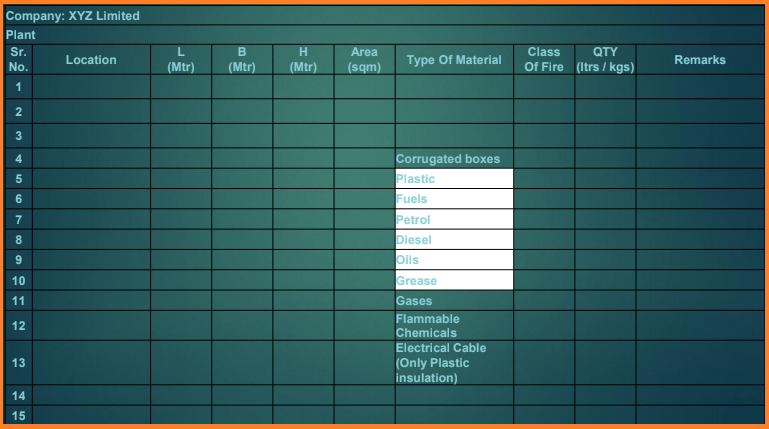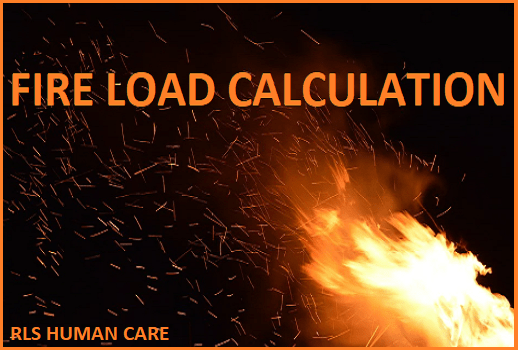Fire Load Calculation
A very important factor in establishing the basis for the analysis of the fire risk pertaining to any building/Factory is the concept of “FIRE LOAD” which indicates the quantity of heat liberated per unit area when a building/Factory and its contents are completely burnt.
Contents
Fire Load Calculation
- The fire load of a building is a number measured in kilograms per- square meter.
- The fire load of a compartment, which can be a building or container, represents the maximum amount of combustible material that is safely stored in that compartment.
- With a few pieces of information and a relatively simple math equation, you are able to correctly determine the fire load of a compartment.
CLICK HERE FOR > Surat fire incident case study
Evaluation of Fire Load Survey Methodologies
- Inventory Method
- Direct Weighing Method
- The Questionnaire Method
- Real Estate Website Review
- Combination Method (Inventory and Weighing)
Fire Load Calculation Back up Requirement
Coordinators
- Drawings
- Documents (Licenses etc..)
- Details of existing Fire Detection & Protection Systems
Core Team Member
- Process Information
- List of Materials with quantities
- Material Data Sheets
Fire Load Calculation Sequence
Survey for
- Process understanding.
- Identification of fire hazards
- Data Collection Guideline for core team member
- Identification of Materials & quantities
- Calculations
- Report and Recommendations
CLICK HERE FOR > HIRA
Fire Load Calculation
Survey for identification of fire hazards

Fire Load Calculation Material & Quantities

Fire Protection Report & Recommendations
All buildings/Factory, etc. can be graded according to their fire hazard and are to be provided for with suitable fire precautions on the basis of the fire load. Hence, the grading of buildings according to both fire load and fire resistance can be made.
Fire Protection
Recommendations
Fire Protection Recommendations are be based on
- National Building Code (NBC) -2016
- Maharashtra Fire Prevention and Life Safety Measures Act of 2006
- Bureau of Indian Standards
- TAC guidelines
- IS 2190: 2010 –Selection of Fire Extinguisher (As per Hazard Category & spacing)
Fire Protection
Recommendations as regards
- Fire Alarm System
- Fire Extinguishers
- Fire Hydrant System
- Fire Sprinkler System
- Fire Suppression Systems
- Fire Prevention Measures
- Fire Load Reduction Measures
- Determine the weight of combustible materials in the compartment for which you wish to calculate the fire load. This value is represented by “W” and is measured in kilograms.
- Determine the value of these materials in calories. This value is represented by “C” and is measured in kilojoules/kilogram.
- Determine the area of the compartment. This value is represented by “A” and is measured in square meters.
- Multiply M by C and divide the total by A to determine the fire load. The equation looks like this:
How to calculate fire load
- Determine the weight of combustible materials in the compartment for which you wish to calculate the fire load. This value is represented by “M” and is measured in kilograms.
- Determine the value of these materials in calories. This value is represented by “C” and is measured in kilojoules/kilogram.
- Determine the area of the compartment. This value is represented by “A” and is measured in square meters.
- Multiply M by C and divide the total by A to determine the fire load. The equation looks like this:
Fire load = (M x C) / A
Fire load and fire demand:
In short:
Fire load is the calculation of material type, quantity, and its calorific value to evaluate head generated/ combustible material fuel present in the area.
Fire demand is generally referred to as fire water demand is the calculation of water required to extinguish the major fire in the premises depending upon fire load.
PLEASE SHARE THIS ARTICLE WITH YOUR RELEVANT FRIENDS







Very nice Sourabah ji. All the safety documents are useful and informative